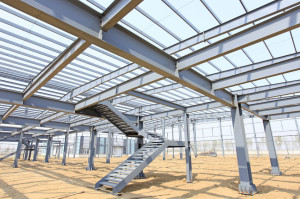Structural steel unites trends in structural engineering
 Several trends in structural engineering all involve structural steel right now. That points to the inherent strengths and utility of the material that make it a go-to solution for structural engineering challenges across the United States and around the world.
Several trends in structural engineering all involve structural steel right now. That points to the inherent strengths and utility of the material that make it a go-to solution for structural engineering challenges across the United States and around the world.
The demands for cost savings, energy efficiency, flexibility and shorter construction times are driving adoption of modular construction practices, involving structural steel, new materials and adaptations in structural engineering.
Structural engineering trends
For the past couple of years, observers of the architecture, engineering and construction industries have been noting several common trends. Increasingly, clients like builders, developers and property owners are demanding:
- Improved energy efficiency
- modular construction
- prefabrication
- improved materials for longer lifespan and more efficient construction
Structural engineering professionals are increasingly turning to structural steel to meet all these demands.
The quest for improved materials
Around the world, structural engineers are looking for better construction materials. The market is demanding longer-lasting, more durable and with better thermal insulation properties.
At the same time, prefabrication and off-site assembly are growing in markets everywhere, especially for industrial and commercial buildings. This technique offers significant cost savings, greater flexibility, shorter construction time and consistent quality.
It also fits perfectly with the trend toward modular construction — a way of erecting structures by stacking prefabricated units together. Modular construction is more productive, faster and provides greater flexibility in erecting commercial building projects, even skyscrapers.
Energy efficiency
Reducing the energy demand of built structures, for heating, cooling and other uses is a major part of the trend to reducing costs. Using panelized steel and modular, prefabricated techniques is an answer to these challenges that’s growing in application around the world. A large part of this is because of another, allied construction material: expanded polystyrene (EPS) panels.
Lightweight, strong, durable, EPS panels are also effective barriers against pests, including rats and termites, and provide good thermal insulation with low installation and maintenance cost.
Evidence
While a lot of people talk about interesting concepts as trends, the international structural engineering market is providing clear evidence of the trend toward structural steel and modular building.
A number of market studies have noted the growth of structural and panelized steel. The production of panelized modular building systems is expected to grow at a compound annual growth rate of 8{ffa1fb9a833dbe70b91c2563ca2a54067368c324c18ffac54b9412388222efff} over the next five years.
According to research firm ResearchAndMarkets, the use of panelized and structural steel in structural engineering projects will grow strongly in the fastest developing markets: Asia-Pacific, North America and Europe. But North America will dominate.
In developing countries, the cost savings, time savings, flexibility and efficiency of prefabrication and modular construction are driving their adoption for a wide range of applications, from residential to commercial and infrastructure construction. Structural steel and modular construction are being used at increasing rates in industrial buildings, such as in large facades, extensive glass surfaces and walls, as well as elements like stairwells and curvilinear roofs.
There are more applications in transportation, mining, shipbuilding, energy industries, and in residential buildings, office spaces and shopping malls.
At the same time, structural steel application is projected to grow in transportation, mining, shipbuilding and energy industries.
According to a study by News Tech Markets, the United States, India and China will account for 57{ffa1fb9a833dbe70b91c2563ca2a54067368c324c18ffac54b9412388222efff} of total growth in construction and engineering industry by 2030.
Another study predicted that North America will dominate the market over the next five years, as it did in 2018. In the United States, 35{ffa1fb9a833dbe70b91c2563ca2a54067368c324c18ffac54b9412388222efff} of contractors are implementing modular construction.
The northeastern region will show the strongest growth due to lower shipping costs and strong growth in large construction projects.
Drivers and brakes
Besides their inherent benefits from a structural engineering and construction perspective, government policies are also driving the adoption of modular construction and panelized steel systems.
Many jurisdictions in the United States and beyond offer homeowners and commercial building owners incentives to reduce their energy consumption. These range from subsidies to install energy-efficient retrofits, to tax reductions or rebates for measures that decrease energy consumption.
In developing countries, the flexibility and savings of modular construction are very attractive, but transportation and logistics sometimes makes adoption more challenging and thus limiting. This is especially the case where transportation infrastructure — roads — are poorly developed.
Modular construction now
Modular construction techniques could be the solution to your construction or development challenge. Let’s sit down and talk about how to save time, money and the environment on your next structural engineering project.

